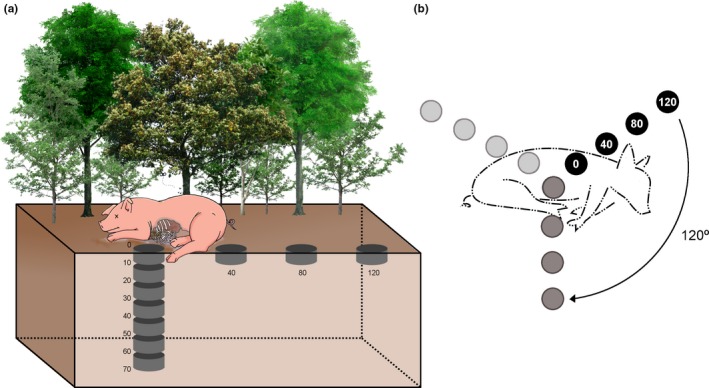Figure 2.

Schematic representation of field sampling to illustrate vertical and horizontal transects with the soil sampling points. Each point corresponds to distances from the pig carcass. These transect directions (a) were defined according to the nesting behaviors of Scarabaeinae: vertical direction for tunnellers (paracoprids) and horizontal direction for rollers (telecoprids), as these are the groups most abundant in Neotropical forests (Halffter et al., 1992). Each sample reached 10 cm depth due to the size of the core soil sampler (a). A schematic view of transects in the above perspective is provided in (b) to show the rotation conducted among the evaluation periods: black circles = “Before” period (before carcass placement); dark gray circles = “During” period (with the carcass in the apex of decomposition); and light gray circles = “After” (after total decomposition of carcass). For the first set of samples (i.e., “Before” period) and for both horizontal and vertical transects within that, a single sample was used per replicate as the first sample (distance 0 cm from pig carcass or origin, so underneath it). For each evaluation period, a new origin was defined as the starting point for both vertical and horizontal transects that went, respectively, down or else horizontally away from the carcass (b); these were taken subsequently on the same date according to distances represented in the scheme. For the subsequent chronological set of samples (evaluation periods), a new origin point was determined to avoid any resampling or effects of experimenter trampling on the soil; the horizontal transects were also moved 120° from the earlier set of horizontal samples (b) to avoid sampling overlap. All vertical transects were performed directly below the carcass (starting from the origin point). The sampling origins were never close to one another than 10 cm. Numbers (a), in centimeters, represent the distances (vertically or horizontally) from the carcass. Tree figures were freely obtained at http://pngimg.com/
